 W
WIn computing, memory refers to a device that is used to store information for immediate use in a computer or related computer hardware device. It typically refers to semiconductor memory, specifically metal–oxide–semiconductor (MOS) memory, where data is stored within MOS memory cells on a silicon integrated circuit chip. The term "memory" is often synonymous with the term "primary storage". Computer memory operates at a high speed, for example random-access memory (RAM), as a distinction from storage that provides slow-to-access information but offers higher capacities. If needed, contents of the computer memory can be transferred to secondary storage; a very common way of doing this is through a memory management technique called virtual memory. An archaic synonym for memory is store.
 W
W3D XPoint is a non-volatile memory (NVM) technology developed jointly by Intel and Micron Technology. It was announced in July 2015 and is available on the open market under the brand name Optane (Intel) since April 2017. Bit storage is based on a change of bulk resistance, in conjunction with a stackable cross-gridded data access array. Initial prices are less than dynamic random-access memory (DRAM) but more than flash memory.
 W
WThe 6264 is a JEDEC-standard static RAM integrated circuit. It has a capacity of 64 Kbit. It is produced by a wide variety of different vendors, including Hitachi, Hynix, and Cypress Semiconductor. It is available in a variety of different configurations, such as DIP, SPDIP, and SOIC. Some versions of the 6264 can run in ultra-low-power mode and retain memory when not in use, thus making them suitable for battery backup applications.ZMD U6264 SRAM
 W
WBank switching is a technique used in computer design to increase the amount of usable memory beyond the amount directly addressable by the processor instructions. It can be used to configure a system differently at different times; for example, a ROM required to start a system from diskette could be switched out when no longer needed. In video game systems, bank switching allowed larger games to be developed for play on existing consoles.
 W
WBubble memory is a type of non-volatile computer memory that uses a thin film of a magnetic material to hold small magnetized areas, known as bubbles or domains, each storing one bit of data. The material is arranged to form a series of parallel tracks that the bubbles can move along under the action of an external magnetic field. The bubbles are read by moving them to the edge of the material where they can be read by a conventional magnetic pickup, and then rewritten on the far edge to keep the memory cycling through the material. In operation, bubble memories are similar to delay line memory systems.
 W
WCache hierarchy, or multi-level caches, refers to a memory architecture that uses a hierarchy of memory stores based on varying access speeds to cache data. Highly-requested data is cached in high-speed access memory stores, allowing swifter access by central processing unit (CPU) cores.
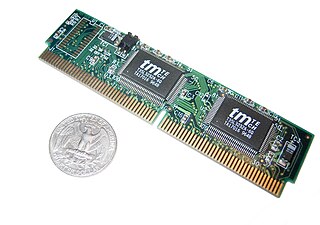 W
WCOASt, an acronym for "cache on a stick", is a packaging standard for modules containing SRAM used as an L2 cache in a computer. COASt modules look like somewhat oversized SIMM modules. These modules were somewhat popular in the Apple and PC platforms during early to mid-1990s, but with newer computers cache is built into either the CPU or the motherboard. COASt modules decoupled the motherboard from its cache, allowing varying configurations to be created. A low-cost system could run with no cache, while a more expensive system could come equipped with 512 KB or more cache. Later COASt modules were equipped with pipelined-burst SRAM.
 W
WIn computer science, a circular buffer, circular queue, cyclic buffer or ring buffer is a data structure that uses a single, fixed-size buffer as if it were connected end-to-end. This structure lends itself easily to buffering data streams.
 W
WCompactFlash (CF) is a flash memory mass storage device used mainly in portable electronic devices. The format was specified and the devices were first manufactured by SanDisk in 1994.
 W
WMagnetic-core memory was the predominant form of random-access computer memory for 20 years between about 1955 and 1975. Such memory is often just called core memory, or, informally, core.
 W
WCore rope memory is a form of read-only memory (ROM) for computers, first used in the 1960s by early NASA Mars space probes and then in the Apollo Guidance Computer (AGC) and programmed by the Massachusetts Institute of Technology (MIT) Instrumentation Lab and built by Raytheon.
 W
WDrum memory was a magnetic data storage device invented by Gustav Tauschek in 1932 in Austria. Drums were widely used in the 1950s and into the 1960s as computer memory.
 W
WDynamic random-access memory is a type of random-access semiconductor memory that stores each bit of data in a memory cell consisting of a tiny capacitor and a transistor, both typically based on metal-oxide-semiconductor (MOS) technology. The capacitor can either be charged or discharged; these two states are taken to represent the two values of a bit, conventionally called 0 and 1. The electric charge on the capacitors slowly leaks off, so without intervention the data on the chip would soon be lost. To prevent this, DRAM requires an external memory refresh circuit which periodically rewrites the data in the capacitors, restoring them to their original charge. This refresh process is the defining characteristic of dynamic random-access memory, in contrast to static random-access memory (SRAM) which does not require data to be refreshed. Unlike flash memory, DRAM is volatile memory, since it loses its data quickly when power is removed. However, DRAM does exhibit limited data remanence.
 W
WError-correcting code memory is a type of computer data storage that can detect and correct n-bit data corruption which occurs in memory. ECC memory is used in most computers where data corruption cannot be tolerated under any circumstances, eg industrial control applications, critical databases, or infrastructural memory caches.
 W
WEEPROM (also E2PROM) stands for electrically erasable programmable read-only memory and is a type of non-volatile memory used in computers, integrated in microcontrollers for smart cards and remote keyless systems, and other electronic devices to store relatively small amounts of data but allowing individual bytes to be erased and reprogrammed.
 W
WFlash memory is an electronic non-volatile computer memory storage medium that can be electrically erased and reprogrammed. The two main types of flash memory, NOR flash and NAND flash, are named after the NOR and NAND logic gates. The individual flash memory cells, consisting of floating-gate MOSFETs, exhibit internal characteristics similar to those of the corresponding gates.
 W
WA flash memory controller manages data stored on flash memory and communicates with a computer or electronic device. Flash memory controllers can be designed for operating in low duty-cycle environments like SD cards, CompactFlash cards, or other similar media for use in digital cameras, PDAs, mobile phones, etc. USB flash drives use flash memory controllers designed to communicate with personal computers through the USB port at a low duty-cycle. Flash controllers can also be designed for higher duty-cycle environments like solid-state drives (SSD) used as data storage for laptop computer systems clear up to mission-critical enterprise storage arrays.
 W
WIn electronics, a flip-flop or latch is a circuit that has two stable states and can be used to store state information – a bistable multivibrator. The circuit can be made to change state by signals applied to one or more control inputs and will have one or two outputs. It is the basic storage element in sequential logic. Flip-flops and latches are fundamental building blocks of digital electronics systems used in computers, communications, and many other types of systems.
 W
WA framebuffer is a portion of random-access memory (RAM) containing a bitmap that drives a video display. It is a memory buffer containing data representing all the pixels in a complete video frame. Modern video cards contain framebuffer circuitry in their cores. This circuitry converts an in-memory bitmap into a video signal that can be displayed on a computer monitor.
 W
WFully Buffered DIMM is a memory technology that can be used to increase reliability and density of memory systems. Unlike the parallel bus architecture of traditional DRAMs, an FB-DIMM has a serial interface between the memory controller and the advanced memory buffer (AMB). Conventionally, data lines from the memory controller have to be connected to data lines in every DRAM module, i.e. via multidrop buses. As the memory width increases together with the access speed, the signal degrades at the interface between the bus and the device. This limits the speed and memory density, so FB-DIMMs take a different approach to solve the problem.
 W
WHigh Bandwidth Memory (HBM) is a high-speed computer memory interface for 3D-stacked SDRAM from Samsung, AMD and SK Hynix. It is used in conjunction with high-performance graphics accelerators, network devices and in some supercomputers. The first HBM memory chip was produced by SK Hynix in 2013, and the first devices to use HBM were the AMD Fiji GPUs in 2015.
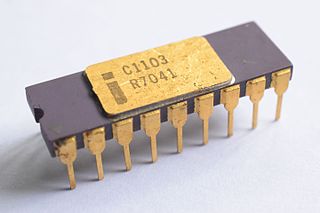 W
WThe 1103 is a dynamic random-access memory (DRAM) integrated circuit (IC) developed and fabricated by Intel. Introduced in October 1970, the 1103 was the first commercially available DRAM IC; and due to its small physical size and low price relative to magnetic-core memory, it replaced the latter in many applications. When it was introduced in 1970, initial production yields were poor, and it was not until the fifth stepping of the production masks that it became available in large quantities during 1971.
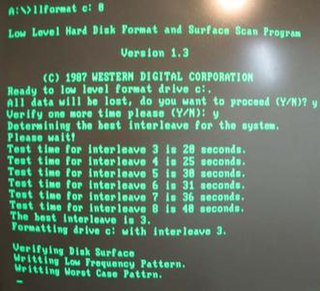 W
WIn disk storage and drum memory, interleaving is a technique used to improve access performance of storage by putting data accessed sequentially into non-sequential sectors. The number of physical sectors between consecutive logical sectors is called the interleave skip factor or skip factor.
 W
WMAI Systems Corp. v. Peak Computer, Inc., 991 F.2d 511, was a case heard by the United States Court of Appeals for the Ninth Circuit which addressed the issue of whether the loading of software programs into random-access memory (RAM) by a computer repair technician during maintenance constituted an unauthorized software copy and therefore a copyright violation. The court held that it did, although the United States Congress subsequently enacted an amendment to 17 U.S.C. § 117 to specifically overrule this holding in the circumstances of computer repair.
 W
WIn computing, a memory address is a reference to a specific memory location used at various levels by software and hardware. Memory addresses are fixed-length sequences of digits conventionally displayed and manipulated as unsigned integers. Such numerical semantic bases itself upon features of CPU, as well upon use of the memory like an array endorsed by various programming languages.
 W
WThe memory cell is the fundamental building block of computer memory. The memory cell is an electronic circuit that stores one bit of binary information and it must be set to store a logic 1 and reset to store a logic 0. Its value is maintained/stored until it is changed by the set/reset process. The value in the memory cell can be accessed by reading it.
 W
WIn computing, a memory module or RAM stick is a printed circuit board on which memory integrated circuits are mounted. Memory modules permit easy installation and replacement in electronic systems, especially computers such as personal computers, workstations, and servers. The first memory modules were proprietary designs that were specific to a model of computer from a specific manufacturer. Later, memory modules were standardized by organizations such as JEDEC and could be used in any system designed to use them.
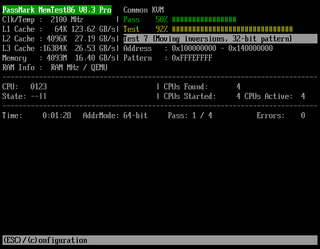 W
WMemTest86 and Memtest86+ are memory test software programs designed to test and stress test an x86 architecture computer's random access memory (RAM) for errors, by writing test patterns to most memory addresses, reading back the data, and comparing for errors. Each tries to verify that the RAM will accept and correctly retain arbitrary patterns of data written to it, that there are no errors where different bits of memory interact, and that there are no conflicts between memory addresses.
 W
WNon-Uniform Memory Access (NUMA) is a computer memory design used in multiprocessing, where the memory access time depends on the memory location relative to the processor. Under NUMA, a processor can access its own local memory faster than non-local memory. The benefits of NUMA are limited to particular workloads, notably on servers where the data is often associated strongly with certain tasks or users.
 W
WThe Open NAND Flash Interface Working Group, is a consortium of technology companies working to develop open standards for NAND flash memory and devices that communicate with them. The formation of ONFI was announced at the Intel Developer Forum in March 2006.
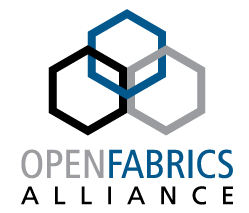 W
WThe OpenFabrics Alliance is a non-profit organization that promotes remote direct memory access (RDMA) switched fabric technologies for server and storage connectivity. These high-speed data-transport technologies are used in high-performance computing facilities, in research and various industries.
 W
WIn computing, a page cache, sometimes also called disk cache, is a transparent cache for the pages originating from a secondary storage device such as a hard disk drive (HDD) or a solid-state drive (SSD). The operating system keeps a page cache in otherwise unused portions of the main memory (RAM), resulting in quicker access to the contents of cached pages and overall performance improvements. A page cache is implemented in kernels with the paging memory management, and is mostly transparent to applications.
 W
WA page table is the data structure used by a virtual memory system in a computer operating system to store the mapping between virtual addresses and physical addresses. Virtual addresses are used by the program executed by the accessing process, while physical addresses are used by the hardware, or more specifically, by the RAM subsystem. The page table is a key component of virtual address translation which is necessary to access data in memory.
 W
WIn computing, PEEK and POKE are commands used in some high-level programming languages for accessing the contents of a specific memory cell referenced by its memory address. PEEK gets the byte located at the specified memory address. POKE sets the memory byte at the specified address. These commands originated with machine code monitors such as the DECsystem-10 monitor; these commands are particularly associated with the BASIC programming language, though some other languages such as Pascal and COMAL also have these commands. These commands are comparable in their roles to pointers in the C language and some other programming languages.
 W
WIn computing, a physical address, is a memory address that is represented in the form of a binary number on the address bus circuitry in order to enable the data bus to access a particular storage cell of main memory, or a register of memory mapped I/O device.
 W
WPumping, when referring to computer systems, is an informal term for transmitting a data signal more than one time per clock signal.
 W
WRandom access is the ability to access an arbitrary element of a sequence in equal time or any datum from a population of addressable elements roughly as easily and efficiently as any other, no matter how many elements may be in the set. In computer science it is typically contrasted to sequential access which requires data to be retrieved in the order it was stored.
 W
WRandom-access memory is a form of computer memory that can be read and changed in any order, typically used to store working data and machine code. A random-access memory device allows data items to be read or written in almost the same amount of time irrespective of the physical location of data inside the memory. In contrast, with other direct-access data storage media such as hard disks, CD-RWs, DVD-RWs and the older magnetic tapes and drum memory, the time required to read and write data items varies significantly depending on their physical locations on the recording medium, due to mechanical limitations such as media rotation speeds and arm movement.
 W
WRead-only memory (ROM) is a type of non-volatile memory used in computers and other electronic devices. Data stored in ROM cannot be electronically modified after the manufacture of the memory device. Read-only memory is useful for storing software that is rarely changed during the life of the system, also known as firmware. Software applications for programmable devices can be distributed as plug-in cartridges containing ROM.
 W
WRecovery Toolbox is a collection of utilities and online services for recovering corrupted files, file formats, and repairing passwords for various programs.
 W
WRegistered memory modules have a register between the DRAM modules and the system's memory controller. They place less electrical load on the memory controller and allow single systems to remain stable with more memory modules than they would have otherwise. When compared with registered memory, conventional memory is usually referred to as unbuffered memory or unregistered memory. When manufactured as a dual in-line memory module (DIMM), a registered memory module is called an RDIMM, while unregistered memory is called UDIMM or simply DIMM.
 W
WA ROM image, or ROM file, is a computer file which contains a copy of the data from a read-only memory chip, often from a video game cartridge, or used to contain a computer's firmware, or from an arcade game's main board. The term is frequently used in the context of emulation, whereby older games or firmware are copied to ROM files on modern computers and can, using a piece of software known as an emulator, be run on a different device than which they were designed for. ROM burners are used to copy ROM images to hardware, such as ROM cartridges, or ROM chips, for debugging and QA testing.
 W
WThe Selectron was an early form of digital computer memory developed by Jan A. Rajchman and his group at the Radio Corporation of America (RCA) under the direction of Vladimir K. Zworykin. It was a vacuum tube that stored digital data as electrostatic charges using technology similar to the Williams tube storage device. The team was never able to produce a commercially viable form of Selectron before magnetic-core memory became almost universal.
 W
WSequential access is a term describing a group of elements being accessed in a predetermined, ordered sequence. It is the opposite of random access, the ability to access an arbitrary element of a sequence as easily and efficiently as any other at any time.
 W
WA shift register lookup table, also shift register LUT or SRL, refers to a component in digital circuitry. It is essentially a shift register of variable length. The length of SRL is set by driving address pins high or low and can be changed dynamically, if necessary.
 W
WThe Silicon Disk System was the first commercially available RAM disk for microcomputers.
 W
WStatic random-access memory is a type of random-access memory (RAM) that uses latching circuitry (flip-flop) to store each bit. SRAM is volatile memory; data is lost when power is removed.
 W
WStrataFlash is a NOR flash memory technology first developed by Intel.
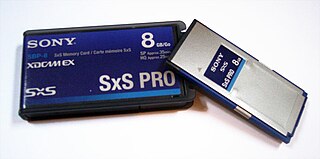 W
WSxS (S-by-S) is a flash memory standard compliant to the Sony and SanDisk-created ExpressCard standard. According to Sandisk and Sony, the cards have transfer rates of 800 Mbit/s and burst transfer rate of up to 2.5 Gbit/s over the ExpressCard's PCI Express interface. Sony uses these cards as the storage medium for their XDCAM EX line of professional video cameras.
 W
WU61000 was the first 1-Mbit DRAM microchip produced in the German Democratic Republic by Zentrum Mikroelektronik Dresden in September 1988 based on CMOS technology.size: 12.60 mm x 4.53 mm DRAM organisation: 1024k x 1 Bit access time: 100 ns - 120 ns
 W
WVault Corporation v Quaid Software Ltd. 847 F.2d 255 is a case heard by the United States Court of Appeals for the Fifth Circuit that tested the extent of software copyright. The court held that making RAM copies as an essential step in utilizing software was permissible under §117 of the Copyright Act even if they are used for a purpose that the copyright holder did not intend. It also applied the "substantial noninfringing uses" test from Sony Corp. of America v. Universal City Studios, Inc. to hold that Quaid's software, which defeated Vault's copy protection mechanism, did not make Quaid liable for contributory infringement. It held that Quaid's software was not a derivative work of Vault's software, despite having approximately 30 characters of source code in common. Finally, it held that the Louisiana Software License Enforcement Act clause permitting a copyright holder to prohibit software decompilation or disassembly was preempted by the Copyright Act, and was therefore unenforceable.
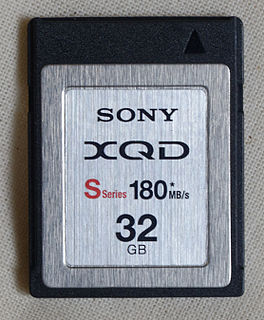 W
WXQD card is a memory card format primarily developed for flash memory cards. It uses PCI Express as a data transfer interface.